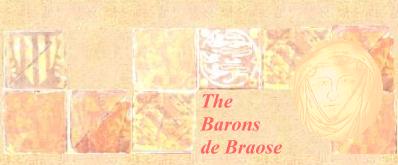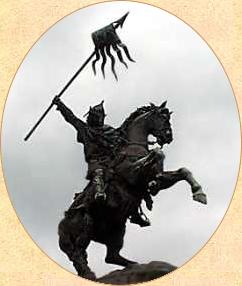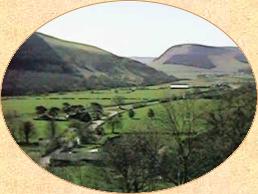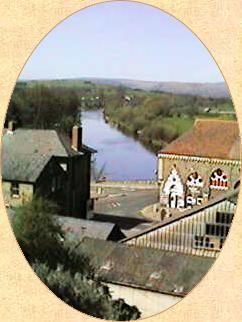
Norman
Warriors
 William de Braose's first wife is said to be Agnes,
daughter of Waldron de Saint Clare. He also married the widow
of Anchetil de Harcourt, Eve de Boissey, who already had seven
sons and a daughter. (5.1) Eve's son Robert le Fort was a
Hastings veteran and a close companion of William de Braose.
William de Braose's first wife is said to be Agnes,
daughter of Waldron de Saint Clare. He also married the widow
of Anchetil de Harcourt, Eve de Boissey, who already had seven
sons and a daughter. (5.1) Eve's son Robert le Fort was a
Hastings veteran and a close companion of William de Braose.
The alliance between Braoses
and Harcourts continued for several generations. Robert's son
Philip de Harcourt rose to become a powerful man, first as Dean
of Lincoln and Archdeacon of Evreux, then as King Stephen's Chancellor.
He was a trusted friend of King Henry II and as Bishop of Bayeaux
rebuilt the Cathedral after a great fire. His tomb is still there.
The
Conqueror's survey of land tenancy and feudal dues, the Domesday
Book of 1086, is an impressive statement of Norman supremacy.
Only twenty years after the Battle of Hastings, the old Saxon
aristocracy had all but vanished. William de Braose features
in the survey as an established tenant in chief. The following
year he attended the Conqueror at his death, at the Priory of
Saint Gervais outside Rouen. The King had been impaled on the
pommel of his saddle during an attack on Mantes, when his horse
took fright at the flames. He was buried at the Abbaye aux Hommes in Caen.
 The Conqueror's dying wish was to divide his domains between
his sons Robert and William but the two were incapable of sustaining
peace.
The Conqueror's dying wish was to divide his domains between
his sons Robert and William but the two were incapable of sustaining
peace.
Robert Curthose, the elder
son, became Duke of Normandy but gained the support of many who
believed he should have the English crown too. William Rufus
successfully defended his claim to England but the conflict ruined
many prominent men. The de Braoses appear to have supported the
King. One of those who supported Robert was Judhael of Totnes.
William de Braose's son and heir Philip was married to Judhael's
daughter Aanor. Judhael held extensive lands in Devon, he had
influential connections and his wife was a Breton of the Picquigny
family, but in 1088 Judhael was banished from England and lost
everything.
In 1094, Robert Curthose
gained ground when he besieged Briouze Castle. A supporter of
the King, William Peverel, opposed Robert with 800 men but they
capitulated when it became clear that Rufus had not sent forces
to relieve them. (5.2) William de Braose may have died
during this conflict. He is last seen in 1093 and was certainly
dead by 1096.
 His son Philip had already followed the family's
warrior tradition. The bloody struggle for territory in
the Welsh Marches particularly suited the de Braoses' warring
ambitions and Philip gained an unsteady hold on Radnor and Builth. (5.3)
The Welsh princes who defended these lands as their birthright
launched repeated campaigns.
His son Philip had already followed the family's
warrior tradition. The bloody struggle for territory in
the Welsh Marches particularly suited the de Braoses' warring
ambitions and Philip gained an unsteady hold on Radnor and Builth. (5.3)
The Welsh princes who defended these lands as their birthright
launched repeated campaigns.
Early Norman gains met
with several setbacks but Philip eventually consolidated his
position and was able to build strong castles. The Marcher
Lords held their lands largely outside the jurisdiction of the
English Crown. This policy provided a powerful incentive for
the relentless warfare needed to subdue the Welsh. The Marchers'
autonomy soon challenged the monarchy, however and as their Welsh
alliances extended to marriage a distinctive new aristocracy
arose.
 Philip
de Braose travelled to Jerusalem on the First Crusade of 1096.
(5.4) Robert Curthose was also among
those who responded to the Pope's call to arms. The Crusade was
a welcome relief to men whose fortunes were threatened by hostilities
between Robert and his brother. In fact four out of five Crusaders
failed to return home but Jerusalem was taken from the Turks
in 1099 and, despite the savagery of the conquest, the survivors
were covered in glory.
Philip
de Braose travelled to Jerusalem on the First Crusade of 1096.
(5.4) Robert Curthose was also among
those who responded to the Pope's call to arms. The Crusade was
a welcome relief to men whose fortunes were threatened by hostilities
between Robert and his brother. In fact four out of five Crusaders
failed to return home but Jerusalem was taken from the Turks
in 1099 and, despite the savagery of the conquest, the survivors
were covered in glory.
Philip must have returned
to England a formidable and battle-hardened hero. At this time,
in the year 1100, William Rufus had just died, his youngest brother
Henry had seized the throne and Robert Curthose resumed his rule
in Normandy. Philip de Braose appears as England's tenth most
wealthy baron. (5.5)
By 1106 Henry had defeated
Robert Curthose at the Battle of Tinchebray, twelve miles north
of Domfront and perilously close to Briouze. England and Normandy
were united again under King Henry I but continued wars on the
Continent eventually compromised Philip de Braose. In 1110, King
Henry confiscated his lands.
Philip was back in royal
favour within only two years, however and his barony was restored
to him. (5.6) Philip's wife, Aanor, had enriched
the family with new West Country strongholds (though they were
saddled with legal disputes into the next century). Her father
Judhael had been recalled from exile to become Lord of Barnstaple.

back to text

back to text

back to text

back to text
The alliance between Braoses and Harcourts continued for several generations. Robert's son Philip de Harcourt rose to become a powerful man, first as Dean of Lincoln and Archdeacon of Evreux, then as King Stephen's Chancellor. He was a trusted friend of King Henry II and as Bishop of Bayeaux rebuilt the Cathedral after a great fire. His tomb is still there. The Conqueror's survey of land tenancy and feudal dues, the Domesday Book of 1086, is an impressive statement of Norman supremacy. Only twenty years after the Battle of Hastings, the old Saxon aristocracy had all but vanished. William de Braose features in the survey as an established tenant in chief. The following year he attended the Conqueror at his death, at the Priory of Saint Gervais outside Rouen. The King had been impaled on the pommel of his saddle during an attack on Mantes, when his horse took fright at the flames. He was buried at the Abbaye aux Hommes in Caen.
Robert Curthose, the elder son, became Duke of Normandy but gained the support of many who believed he should have the English crown too. William Rufus successfully defended his claim to England but the conflict ruined many prominent men. The de Braoses appear to have supported the King. One of those who supported Robert was Judhael of Totnes. William de Braose's son and heir Philip was married to Judhael's daughter Aanor. Judhael held extensive lands in Devon, he had influential connections and his wife was a Breton of the Picquigny family, but in 1088 Judhael was banished from England and lost everything. In 1094, Robert Curthose gained ground when he besieged Briouze Castle. A supporter of the King, William Peverel, opposed Robert with 800 men but they capitulated when it became clear that Rufus had not sent forces to relieve them. (5.2) William de Braose may have died during this conflict. He is last seen in 1093 and was certainly dead by 1096.
Early Norman gains met with several setbacks but Philip eventually consolidated his position and was able to build strong castles. The Marcher Lords held their lands largely outside the jurisdiction of the English Crown. This policy provided a powerful incentive for the relentless warfare needed to subdue the Welsh. The Marchers' autonomy soon challenged the monarchy, however and as their Welsh alliances extended to marriage a distinctive new aristocracy arose.
Philip must have returned to England a formidable and battle-hardened hero. At this time, in the year 1100, William Rufus had just died, his youngest brother Henry had seized the throne and Robert Curthose resumed his rule in Normandy. Philip de Braose appears as England's tenth most wealthy baron. (5.5) By 1106 Henry had defeated Robert Curthose at the Battle of Tinchebray, twelve miles north of Domfront and perilously close to Briouze. England and Normandy were united again under King Henry I but continued wars on the Continent eventually compromised Philip de Braose. In 1110, King Henry confiscated his lands. Philip was back in royal
favour within only two years, however and his barony was restored
to him. (5.6) Philip's wife, Aanor, had enriched
the family with new West Country strongholds (though they were
saddled with legal disputes into the next century). Her father
Judhael had been recalled from exile to become Lord of Barnstaple.
|
||||||||